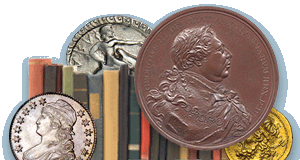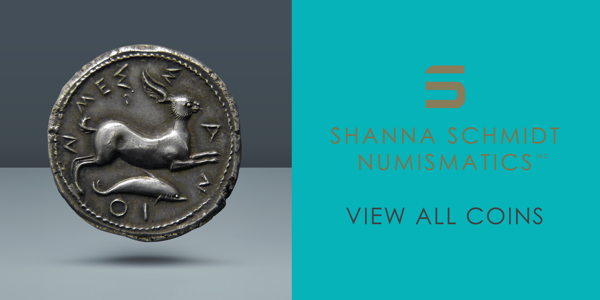
PREV ARTICLE
NEXT ARTICLE
FULL ISSUE
PREV FULL ISSUE
ANA SUMMER SEMINAR 2025, SESSION ONEA few classes for ANA's Summer Seminar 2025 are still open, so register now while you still can! Summer Seminar is one of the premier educational experiences in numismatics. -Garrett
For many students, Summer Seminar is a life-changing event; it has catapulted the careers of several of the nation's most respected collectors, authors and dealers. Classes are designed to suit every collector's interests and include courses such as: Grading U.S. Coins, Detecting Counterfeit and Altered Coins, ancient Greek and Roman coinage, Early American Copper Coinage, Colonial Americana, Morgan Dollars, World Numismatics, and much more. Students gather in small groups, allowing everyone to be an active participant. You'll learn from instructors who are recognized leaders in their fields, and from the collective experiences of fellow students, who range in age from teenagers to seniors. Students may select from a variety of tuition and lodging options to meet their needs, preferences and budget. Activities include seminars and lectures, special events, great food, receptions and banquets, and optional tours. Here are the remaining session one classes for Summer Seminar 2025: Session 1 World Coin Grading This course focuses on learning grading standards for world coins from the perspective of American grading services. The course includes instruction on grading vintage and modern world coins, including normal or special strikes, as well as milled and non-milled coinage. Segments of the course are dedicated to detecting and identifying no-grade and problem coins, as well as counterfeit-coin detection. Instructors: Jay Turner, senior world coin grader, PCGS; and Dylan Dominguez, junior world coin grader, PCGS. Introduction to Counterfeit & Alteration Learn how counterfeits are made from ancient times to today. Chinese counterfeits that have entered the coin market over the last 30 years are emphasized. This plague is not because of the sophistication of counterfeits but because of the sheer number in the market. Examine Chinese counterfeits and see how easily you can spot them. If you work in law enforcement, you'll gain the confidence to go to court and prove your case. If you're buying coins online or through the mail, or work at a coin shop, pawn shop, or as a vest pocket dealer, you will benefit from this class. Instructors: Brian Silliman, professional numismatist, Brian Silliman Rare Coins, and former NGC grader/conserver and ANA authenticator/conserver; and Jim Robinson, professional numismatist, APMEX The Wonderful World of Paper Money Paper money has been used for centuries, primarily for economic purposes but also for many others. Just as the Romans used their coinage to advertise Imperial accomplishments, so paper in later centuries has been used to celebrate a nation's history, peoples, and conquests. During hard times, the paper usually reflects those issues. Take a tour covering more than 600 years of paper money, including how it is made, what it represents, its artistry, and where it is going from here. (Soon it may not be "paper" money any longer.) Classroom time includes many hours of handling notes, not simply reviewing slideshows. Pick the countries or periods you are interested in and enjoy. Instructor: Joseph E. Boling, ANA chief exhibit judge, coauthor of World War II Remembered: History in Your Hands, A Numismatic Study The Modern Minting Process: Errors & Varieties Explore the minting process and learn how each step can lead to a collectable coin. Topics include how coins are produced, the identification and description of errors, and the art of cherrypicking varieties. Included is hands-on examination of some amazing error and variety coins. Students are encouraged to also bring their own errors or varieties to discuss. A visit to the Moonlight Mint is included, where students watch the production process, from the design phase to the striking of coins. Students also get to press the button on a Grabener coin press to strike their own medallions to take home. This class fulfills the "Modern Minting Process/U.S. Minting Errors and Varieties" course requirement for the ANA Numismatic Diploma Program. Instructors: John H. Miller Jr., ANA district representative and CONECA variety attributor; and Greg Bennick, error specialist, CONECA and TAMS board member Numismatic Digital Photography & Image Editing This course is designed for beginners through advanced photographers who want to learn basic and advanced techniques to take photographs of numismatic items and manage their digital coin collection, using photographs to sell coins online, conduct research using numismatic photographs, perform diagnostic inspection of numismatic items, or submit images for publication. Learn how to use multiple lighting configurations and get the most out of your equipment. Discover proper image capture and file handling methods for efficiency. Learn basic numismatic editing techniques using Adobe Photoshop/Elements to produce proper image results and management. Students are encouraged (but not required) to bring a DSLR camera with a macro lens, a laptop with Photoshop or Photoshop Elements, and several personal numismatic items to photograph. Instructors: Clark Fogg, CSI forensic consultant and numismatic photographer, historian, and author; and David Heinrich, numismatic editor and photographer, ANA governor Collecting and Investing in Morgan Silver Dollars This course provides a comprehensive and professional overview of collecting and investing in Morgan silver dollars. Discover the subtle nuances of the dates and mintmarks, and learn about varieties, die states, prooflike (PL), and deep mirror prooflike (DMPL) coins, planchet variations, strike, toning, and eye appeal. Students study extant populations, grading and grading services, wholesale and retail pricing, supply and demand, and critical resources of information. Using actual examples, learn how to grade, as well as determine, rare die varieties and errors, and learn how best to buy, sell, or trade Morgan dollars. Whether you are a beginning collector, dealer, or seasoned Morgan collector, you will learn about collecting and investing in Morgan dollars from two of the most knowledgeable and well-respected experts on the subject. The knowledge gained from this class will serve you well throughout the course of your collecting and investing in one of the most popular series in numismatics. Instructors: John Baumgart, owner, Variety Slabbing Service; Chris Simpson, founding member, grader, and main variety attributor with CAC Grading Collecting and Attributing Capped Bust Half Dollars This course provides students with a brief history of U.S. coins from 1792 to 1832, focusing on the Capped Bust half dollar. This course covers the minting process and variety attribution. Students receive hands-on experience in determining Overton varieties on many Capped Bust half dollars. This seminar also discusses grading Capped Bust half dollars, as well as counterfeit detection. Instructors: Bruce Breedlove, coin dealer and collector, cofounder of Classic City Coin Club (Athens, Georgia); Eric Kibbey, owner of Camelot Coins, LLC, secretary of Richmond Coin and Currency Club (Richmond, Indiana); Steven Roach, ANA numismatic educator Coins of the Roman Republic Coins uniquely illustrate ancient Roman culture. Using resources from the Edward C. Rochette Money Museum and Dwight N. Manley Numismatic Library collections, students follow the development of Roman Republican coinage – from its Greek roots to its eventual dominance of the Mediterranean economy under the Roman Empire. This fascinating journey brings to life the intriguing political figures, mysterious gods and goddesses, and exciting historical events of this volatile time. Instructors: Douglas Mudd, ANA Money Museum curator and director, and instructor at the ANA Summer Seminar since 2002; and Kerry K. Wetterstrom, past president of the Ancient Coin Collectors Guild, former auction director and senior numismatist at Classical Numismatic Group, former editor and publisher of The Celator magazine, and an instructor at the ANA Summer Seminar since 1990 Greek Coins from the Origin of Money to the Rise of Alexander the Great This seminar examines the origins of coinage in 7th century B.C., Asia Minor and the adoption of coins throughout the Greek world through the rise of Alexander the Great of Macedon in 336 B.C. Instructors: Mike Gasvoda, managing director of Classical Numismatic Group; and Dave Michaels, director of shows and assignments at Classical Numismatic Group (Lancaster, Pennsylvania, and London, England) Early American Copper Coinage (Copper 1) This course provides an introduction to early American coppers. Students gain a basic understanding of early American coppers, including how they were distributed by the mint, where and how they circulated, how to determine if a copper has been cleaned or altered, and how restrikes were made. Learn how to grade and attribute higher-graded coins. Topics are student-driven—if you want to know something, just ask! Bring your loupe and any coppers you would like to share. Instructors: Jim Carr, Early American Coppers (EAC) member, professional numismatist, Carr's Coins; and Kevin Vinton The New Orleans Mint Coinage and its History This course covers the coins and the history of the New Orleans Mint from its origin in 1835 to its final closure in 1909. The silver and gold coins produced at the New Orleans Mint are comparable to the Philadelphia Mint both in type and quantity. From arduous early days marked by epidemics and deaths, a struggle to mint coins with limited dies being stored in tropical conditions, to changing hands three times during the Civil War, its complicated history is written in its coins. The course includes discussions of the 40 (or so) types of New Orleans coins, individual dates, major varieties, grading, and hands-on attribution exercises. Instructors: Craig Eberhart, secretary, Liberty Seated Collectors Club; Len Augsburger, project coordinator of Newman Numismatic Portal, president of the Liberty Seated Collectors Club, president of Numismatic Bibliomania Society; and John Frost, director of education of the Liberty Seated Collectors Club and president of the Barber Coin Collectors Society A Survey of 20th- & 21st-Century World Coins Participants in this class have the opportunity to appreciate the artistry, history, geography, people, and stories of the modern world through the study of modern world coinage. Participants explore common, scarce, artistic, ugly coins. Knowledge will range from general to specifics in areas of general issues, commemoratives, metals, designers, mintages, patterns, errors, and topicals. Grading and the preparation of balanced talks, articles, and exhibits of modern issues are discussed. Instructor: Benjamin Swagerty, media specialist for OKCPS, master referee for Numista, international numismatic researcher
To read the full course catalog and register, see:
Wayne Homren, Editor The Numismatic Bibliomania Society is a non-profit organization promoting numismatic literature. See our web site at coinbooks.org. To submit items for publication in The E-Sylum, write to the Editor at this address: whomren@gmail.com To subscribe go to: Subscribe All Rights Reserved. NBS Home Page Contact the NBS webmaster 
|


